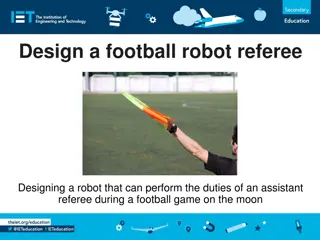Mind Controlled Robot Project by Adithya Kumar - Eighth Grade
Adithya Kumar, an eighth-grade student, has designed a groundbreaking Mind Controlled Robot project that allows users to control a robot using brain waves. The project utilizes a Mindwave EEG headset, Arduino Uno motherboard kit, and various materials. Adithya's detailed experimental design and procedures for robot design and connecting the RF dongle to Arduino offer valuable insights for aspiring young engineers and technology enthusiasts.
Download Presentation

Please find below an Image/Link to download the presentation.
The content on the website is provided AS IS for your information and personal use only. It may not be sold, licensed, or shared on other websites without obtaining consent from the author.If you encounter any issues during the download, it is possible that the publisher has removed the file from their server.
You are allowed to download the files provided on this website for personal or commercial use, subject to the condition that they are used lawfully. All files are the property of their respective owners.
The content on the website is provided AS IS for your information and personal use only. It may not be sold, licensed, or shared on other websites without obtaining consent from the author.
E N D
Presentation Transcript
MIND CONTROLLED ROBOT BY ADITHYA KUMAR EIGHTH GRADE
ENGINEERING GOAL The goal of my Mind Controlled Robot project is to design a Robot which can be controlled by using brain waves. I developed the robot prototype using Mindwave EEG headset and the Arduino Uno motherboard kit.
EXPERIMENTAL DESIGN INTRODUCTION The main goal of my mind controlled Robot is to allow the user to control a simple robot using brain waves. I designed the mind controlled robot using Mindwave Headset, Arduino and a basic robot.
MATERIALS USED Neurosky Mindwave RF Dongle Small solderless breadboard 1 Castor wheel Motor Controller Assorted wires in different colors 4 L shaped brackets Battery pack 4 pin connector Screws Soldering Iron Volt meter Hammer, Pliers, Wrench & Knife Marker Arduino Uno Mother Board Two 3-6 volts DC servo motors Two-state Power Switch Two 3D printed wheels Chasis Double sided mounting tapes Piezo Speaker 4 AA batteries Laptop with Arduino IDE Washers Lead free soldering material Arduino IDE Philips screwdriver
Procedure Robot Design 1. 2. 3. 4. Attach the servos onto the servo mounts using 4 nuts and 4 bolts. Attach the servo mounts onto the chassis with the L-brackets and screws. Attach the wheels to the mounted servo motors. Attach the Castor wheel onto the Chassis using 2 washers, 2 nuts and 2 bolts. Attach the solderless breadboard onto the top of the chassis using the double sided foam tape. Attach the Arduino uno to the Chassis using 4 nuts. Feed the nuts through the four threaded holes in the Arduino. Attach the battery pack which powers the servos onto the Chassis and wire them up accordingly. Attach the motor controller into the bread board as shown in the schematic diagram below. Wire up both the motors, motor controller and Arduino as shown in the schematic diagram. 10. Program the Arduino to move the robot front and back using the Arduino IDE. Load the program into the Arduino and test the robot 5. 6. 7. 8. 9.
Procedure Connecting the RF Dongle to Arduino Connecting the dongle to the Arduino Board requires removing the plastic covering from the dongle and soldering wires to 4 of the pins. 1. Remove the plastic covering from the USB dongle. 2. Once the cover is off, the RF dongle board will be as shown in the picture below: Dongle Schematic
3. 4. Find the 4 pins, located in the center of the board. Starting at the end with the + sign the pin assignments are: Pin 1 (starting at +): 3.0 V Power Pin 2 : TX Pin 3 : RX Pin 4 : Ground 5. Connect a 4 pin connector into these pins. 6. Connect wires to these 4 pins, leaving enough wire to connect to the Arduino. 7. Use a Knife to destroy the connections from these PINs to the Chip inside the RF dongle. This is to ensure that the brain wave signals received from the Mindwave is sent to the Arduino and no the internal chip in the RF dongle. 8. The Mindwave RF dongle uses a 3.3 V power. Connect the +ve of the RF dongle to Arduino s 3.3 V Output pin. 9. Connect the dongle s Tx directly to the Arduino s Rx(Pin 0). Connect the dongle s Rx to the Arduino s Tx (pin 1). You can add a voltage divider to reduce the voltage going to the dongle s Rx pin because Arduino sends 5V whereas Dongle uses only 3.3 V. It is not absolutely necessary to add a voltage divider but it is good to avoid any harm caused using the excess voltage. 10.Connect the dongle s GND to Arduino s GND
Procedure Pairing the Mindwave with Arduino (using the RF Dongle) Turn both the Mindwave headset and Arudino. The LEDs in the Mindwave and the RF dongle will be red initially. Pair the RF dongle and the Mindwave headset by sending the instruction 0XC2 to the RF dongle from Arduino. Once they are paired the LED in both the Mindwave and the Arduino turns blue. The Arduino is ready to received instruction from the Mindwave now. 1. 2. 3. 4.
Procedure Mind Controlled Robot 1. 2. Load the Arduino Program into Arudino. Read the attention level received from the Mindwave through the RF dongle. If the attention level is greater than 50 (when the user is focusing), move the motors of both the servos forward. If the attention level is less than 50, move the motors back 3. 4.
3D Printed Wheels of the Robot Connecting the RF Dongle with the Arduino Mind Controlled Robot In Action Fully Completed Robot


![[PDF⚡READ❤ONLINE] Zen Mind, Beginner's Mind: 50th Anniversary Edition](/thumb/20459/pdf-read-online-zen-mind-beginner-s-mind-50th-anniversary-edition.jpg)




















